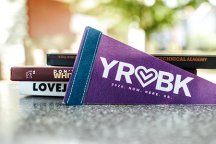When it comes to creating a yearbook, knowing how to write a yearbook story/caption is important. Use visual nouns, active verbs, third person and past tense. Leave some white space; let your story breathe. Lastly, take time to write focused, meaningful and engaging yearbook stories. You’ll end up with a stronger picture of your school year.
Make your photographs timeless with quality captions.
Captions are an essential piece of yearbook reporting, providing the reader with material unseen in the photograph alone.
CAPTION TYPES
There are four basic types of captions: The standard caption, the group caption, identifications (or idents) and a single quote.
- STANDARD CAPTION (PREFERRED)

- Otherwise known as an expanded caption. Though space can limit its use, it is ideal for
each photograph to have a standard, three-sentence caption. When a full caption is not possible, a caption without a direct quote or second sentence are acceptable.
■ Lead In: Two or three words, the lead-in serves as a mini-headline for the caption.
■ Sentence 1: (present tense) Identifies people (up to 5) in the picture using first and last names and grade levels. Gives most important of 5 W’s and H
(who, what, where, when, why, and how).
■ Sentence 2: (past tense) Provides background information that cannot be seen in the photo. Includes any remaining W’s and H.
■ Sentence 3: A direct quote from a person in the photo, attributed with the word “said.” It can be more than one sentence, if necessary.
- GROUP CAPTION
A group caption might be used alongside a small grouping of photographs. A group caption functions to assist design and by placing the caption to the side of the photos, the text does not distract from them. Captions in a group should be limited to no more than five photographs for readability purposes. Group captions follow the same format as a standard caption, but often combine sentences 1 and 2. Quotes are not necessarily included for each photograph, but there may be one quote for every two photos, as space allows. Some prefer group captions because they consolidate the design space needed for captions. When working with group captions, consider using a design element to create a break between photo information to improve readability.

3. IDENTIFICATIONS – Indents are simply a name and grade level designation, placed alongside a photograph. Ideally these are only used on headshots and cutouts. Note that an extended identification may be a single sentence with a few details added. For example: Jessie Lucas (8) sings The Sound of Music.

4. QUOTES – Quotes, when used as captions, are a form of quick read. They may be used in a page module, intended to tell a story from the perspective of the student pictured. Students should be attributed with their full name and grade level.

RESOURCES
Since yearbook captions involve a specific writing style that may be unfamiliar to novice staffers, it can be helpful to provide students with instructional expectations. Whether a direct lesson or reference sheets, students can improve the quality of their caption writing with just a few quick tips and tricks.
Learn more about writing a good story from Bobby Hawthorne


